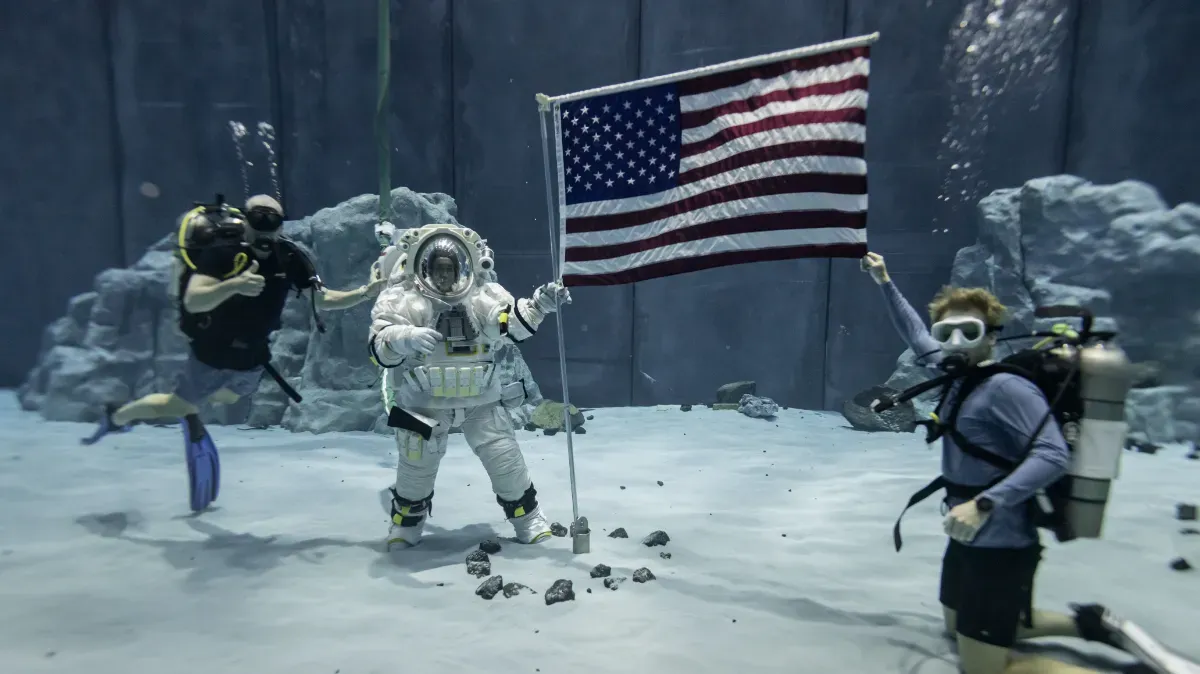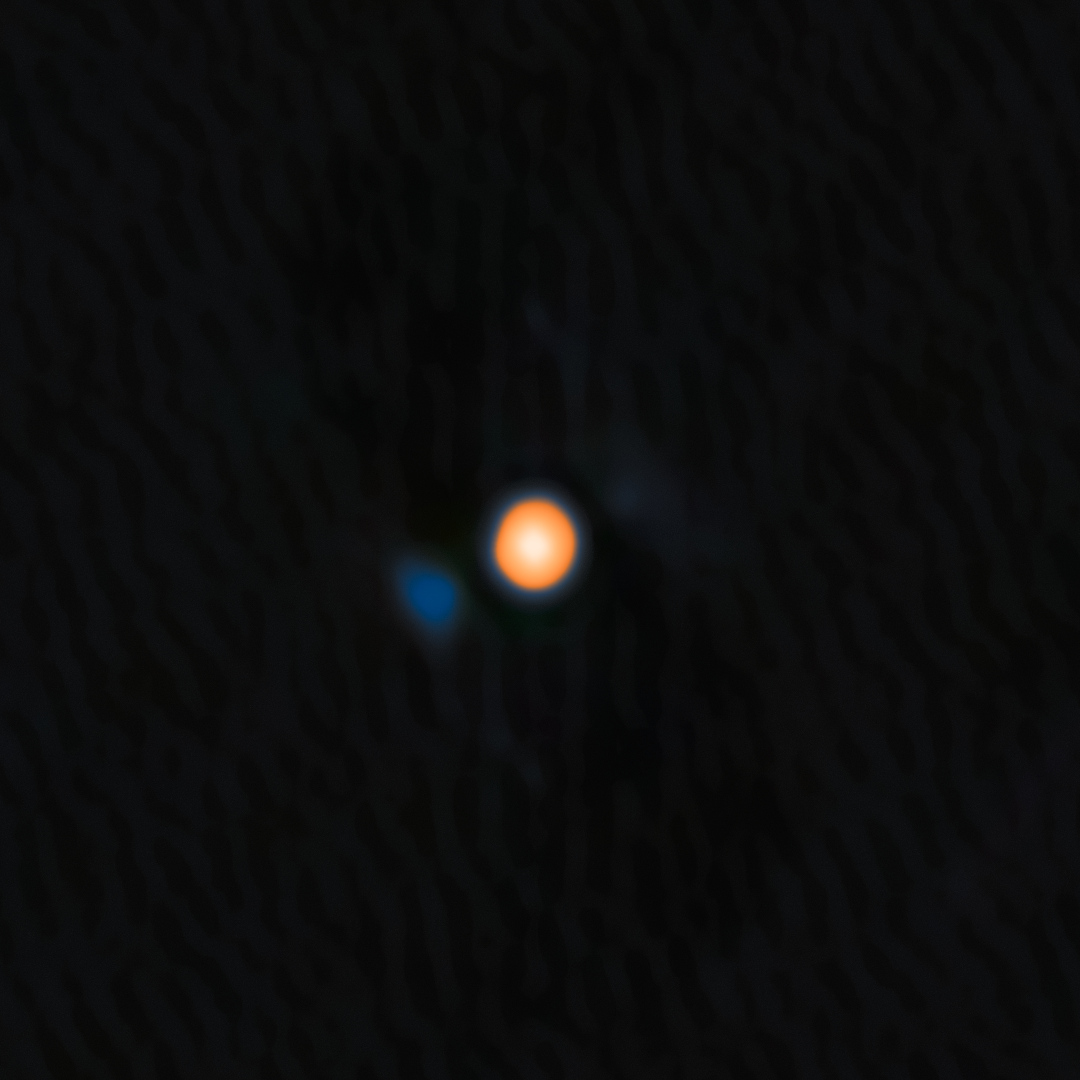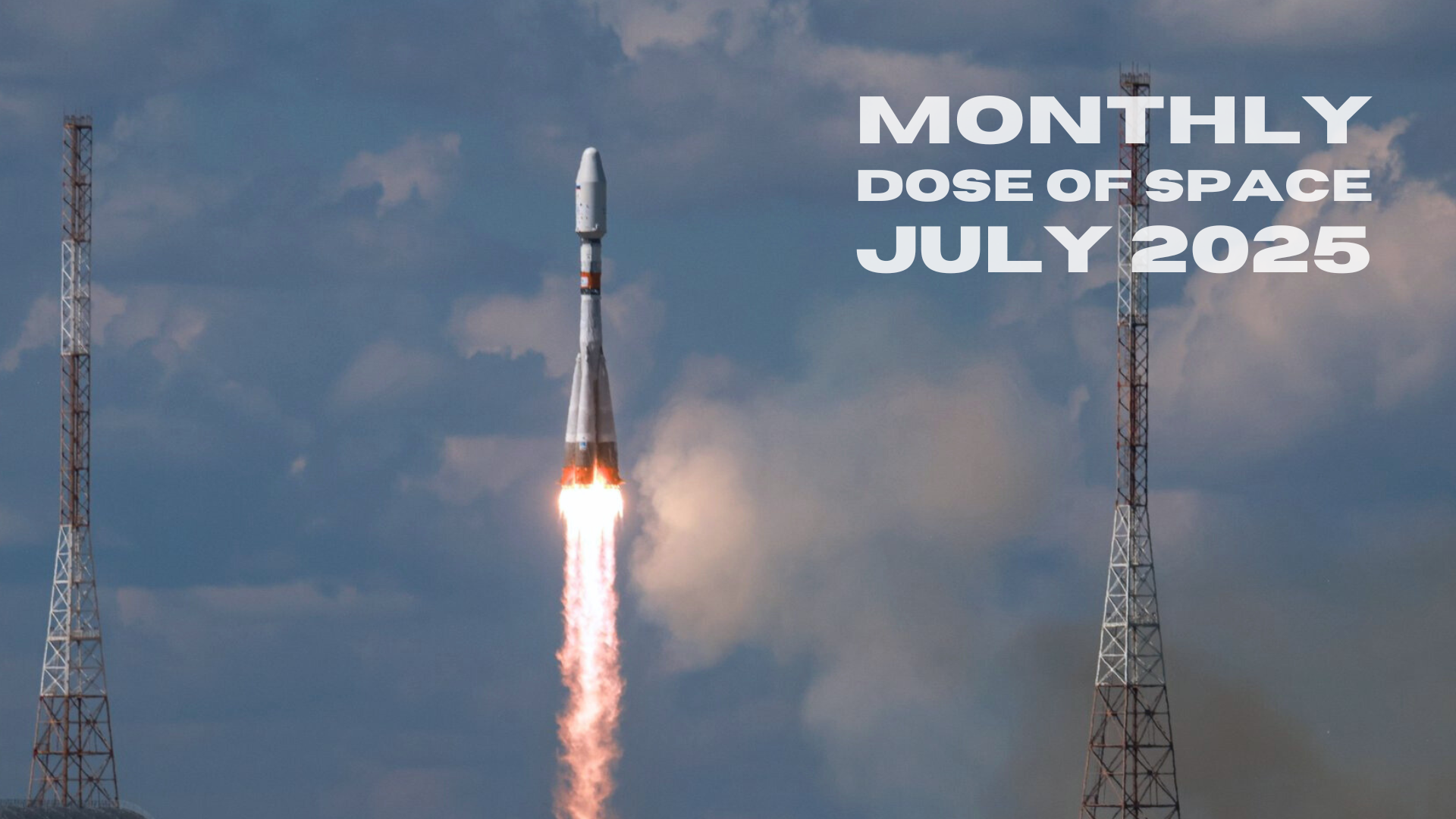Table of Contents
Welcome to our twenty-second Monthly Dose of Space! In this monthly newsletter, we bring you major news from the past month. The end of July continues a busy year, so let's jump into the past month!
News of the Month
News during July had China update its commercial space regulation, NASA funding restoration efforts being delayed, New Glenn preparing to fly again, Axiom Space testing its lunar spacesuit, and findings from Betelgeuse.
Axiom tests spacesuit with astronaut

Axiom Space announced on July 8th that two months ago, astronaut Koichi Wakata, also the company's Chief Technology Officer, tested the AxEMU spacesuit for the first time with a human inside, in NASA’s Neutral Buoyancy Laboratory used for spacewalk training.
According to the company, Wakata's testing of the AxEMU saw him accompanied by engineers to properly test the operations and capabilities of the communications, breathing, and cooling systems of the spacesuit in the facility. Axiom did not disclose the outcomes of its testing, but it is believed to have gone well.
At the moment, the AxEMU spacesuit is expected to have its Critical Design Review later this year, ahead of the Artemis III mission to the lunar surface in 2027. Further testing and training with the spacesuit are planned to support the mission and its crew.
New Glenn targets Mars!
Blue Origin shared on July 17th that the second flight of its New Glenn rocket will target Mars later this year. It is currently expected that the flight will occur no earlier than mid-August.
The mission will carry two Rocket Lab-built spacecraft for NASA's ESCAPADE mission to study the planet's magnetosphere, while demonstrating low-cost exploration missions. Also set to be onboard is a technology demonstration from Viasat in support of NASA's Communications Services Project, aiming to develop relay services near Earth.
In recent weeks, Blue Origin Chief Executive Officer, Dave Limp, has shared that the seven first-stage BE-4 engines for the mission were ready to be installed on the second New Glenn vehicle, while the two second-stage BE-3U engines were fired up in April and ready to fly.
Another view… https://t.co/Zu73mWk1pj pic.twitter.com/4mzkhOesqV
— Dave Limp (@davill) April 24, 2025
New Glenn's second-stage performing a static fire in April ahead of the rocket's second mission, via Dave Limp on Twitter.
NASA funding held up
Currently, U.S. politicians are moving to restore science funding to NASA slashed by the Trump Administration, through a series of bills signed. The Commerce-Justice-Science bill to do so has been progressing through the legislative process.
However, House Speaker Mike Johnson (Republican) has sent American lawmakers off to an early five-week summer recess, on July 22nd, that will last until September 2nd, just four weeks until agency funding deadlines. The early recess was called due to political upheaval, on both sides of the U.S. political aisle, that could have seen the release of files related to the notorious disgraced financier and sex offender Jeffrey Epstein, which would have fully detailed President Donald Trump's involvement.
If the bill is not passed before a deadline of October 1st, Ars Technica reports that officials from the Trump Administration intend to go with its intended cuts to NASA. That would cut NASA science by half and end many working and almost ready-to-launch missions.
Commercial space regulations updated in China
The China National Space Administration shared updates to China's commercial space regulations on Just 21st, with the new rules approved a few days prior on July 16th. These rules update laws around quality control, accountability, and requirements for the nation’s growing commercial space sector.
The new regulations are made up of thirty-nine points across eight key areas: General Requirements, Quality Management Systems, Research and Development and Production, Ground Testing, Launch Implementation, On-Orbit Operations, Services, Recovery, and Decommissioning, Product Quality Supervision, and Accident Investigation and Disposal. Officials from the China National Space Administration told Xinhua that the new regulations standardize responsibilities across the mentioned areas.
Betelgeuse companion star found

Betelgeuse, a supergiant star best known for being expected to go supernova anytime between now and one hundred thousand years from now, has been found to have a companion star this month. The companion star is yet to be named, although informally called the Betelbuddy.
Fluctuations in the brightness of Betelgeuse had puzzled scientists with what's happening with the star, those fluctuations were found to be the companion star moving in front. For many decades, Betelgeuse's overpowering brightness hid its companion, with observations of it only being possible in certain parts of the smaller star's orbit around the supergiant.
Better observations of Betelgeuse's companion will be possible around November 2027, when they are at their furthest separation from one another.
Launches of the Month
This month saw 24 launches worldwide, continuing a busy year. If you want to know what each launch was we have them all listed below!
July 1st - Falcon 9 with MTG-S1
A Falcon 9 launched the MTG-S1 spacecraft from Launch Complex 39A, in Florida, to a geostationary transfer orbit. Supporting this mission was booster B1085, for its ninth flight, with a landing on the drone ship 'Just Read The Instructions' downrange.
July 2nd - Falcon 9 with Starlink Group 10-25
Another Falcon 9 launched twenty-seven Starlink satellites to low Earth orbit from Space Launch Complex 40, in Florida. Booster B1067 supported this launch for its twenty-ninth flight, landing downrange on the drone ship 'A Shortfall Of Gravitas'.
July 3rd - Long March 4C with Shiyan-28B-01
A Long March 4C blasted off from the Xichang Satellite Launch Center carrying Shiyan-28B-01 to low Earth orbit. Shiyan-28B-01 is planned to be utilized for space environment detection and related technical tests, which may include tracking other spacecraft and debris.
July 3rd - Soyuz 2.1a with Progress MS-31
A Soyuz 2.1a launched from the Baikonur Cosmodrome carrying the Progress MS-31 spacecraft toward the International Space Station. Following launch, Progress MS-31 docked to the Poisk module on the Russian segment of the space station.
July 8th - Falcon 9 with Starlink Group 10-28
A Falcon 9 launched from Space Launch Complex 40, in Floirda, carrying twenty-eight Starlink satellites to low Earth orbit. Supporting this mission was booster B1077 for its twenty-second flight, with a landing downrange on the drone ship 'A Shortfall Of Gravitas'.
July 13th - Falcon 9 with Dror-1
Heading to a geostationary transfer orbit, a Falcon 9 launched the Israel Aerospace Industries' Dror-1 communications satellite from Space Launch Complex 40, in Florida. Supporting this mission was booster B1083 for its thirteenth flight, with a landing downrange on the drone ship 'Just Read The Instructions'.
This was also Falcon 9's 500th mission.
July 14th - Long March 7 with Tianzhou-9
From Launch Complex 201 at the Wenchang Space Launch Site, a Long March 7 blasted off carrying the Tianzhou-9 cargo resupply spacecraft, heading for low Earth orbit and eventually the Tiangong Space Station (docking about three hours after launch). Onboard the spacecraft are scientific experiments, two new and improved Feitian spacesuits, along with food and other consumables. Propellant will also be transferred to the space station for its maneuvering and attitude control systems.
July 16th - Falcon 9 with Starlink Group 15-2
Twenty-six Starlink satellites headed to low Earth orbit atop of a Falcon 9 from Space Launch Complex 4E, in California. Booster B1093 supported this launch for its fourth flight, landing on the drone ship 'Of Course I Still Love You' downrange.
July 16th - Falcon 9 with KF-01
A Falcon 9 launched from Space Launch Complex 40 headed for low Earth orbit, carrying twenty-four Kuiper satellites for Amazon, bringing the constellation up to seventy-eight satellites. In support of the mission was a brand new Falcon 9 booster, B1096, was performing its first flight, and landing in the Atlantic Ocean on the drone ship 'A Shortfall Of Gravitas'.
July 19th - Falcon 9 with Starlink Group 17-3
Another twenty-four Starlink satellites were delivered to low Earth orbit by a Falcon 9 flying from Space Launch Complex 4E. Booster B1082 supported the mission, for its fourteenth flight, along with a landing on the drone ship 'Of Course I Still Love You' downrange.
July 22nd - Falcon 9 with two O3b mPOWER satellites
SpaceX launched two O3b mPOWER communications satellites to a medium Earth orbit from Space Launch Complex 40, in Florida, atop of a Falcon 9. Supporting this mission was booster B1090, for its sixth flight and landing downrange on the drone ship 'Just Read The Instructions'.
July 23rd - Falcon 9 for multiple missions
A Falcon 9 is to lifted off from Space Launch Complex 4E, in California, carrying NASA's TRACERS (Tandem Reconnection and Cusp Electrodynamics Reconnaissance Satellites), PExT (Polylingual Experimental Terminal), and Athena EPIC (Economical Payload Integration Cost) missions to sun-synchronous orbit alongside Dartmouth College's REAL (Realistic Electron Atmospheric Loss) mission. Booster B1081 supported this mission for its sixteenth flight, landing back at Landing Zone 4 inside the Vandenberg Space Force Base.
July 25th - Soyuz 2.1b with two Ionosfera-M satellites
A Soyuz 2.1b launched two Ionosfera-M ionospheric and magnetospheric research satellites to sun-synchronous orbit from the Vostochny Cosmodrome. Eighteen other small spacecraft were also onboard, including the Iranian Nahid-2 telecommunications satellite.
July 26th - Vega-C with CO3D & MicroCarb
Vega-C launched from the Guiana Space Centre carrying five satellites to sun-synchronous orbit for CO3D and MicroCarb missions. Four CO3D spacecraft for Earth observations were onboard, while the MicroCarb satellite is planned to map sources and sinks of carbon dioxide.
July 26th - Falcon 9 with Starlink Group 10-26
Twenty-eight Starlink satellites were launched to low Earth orbit from Space Launch Complex 40 via a Falcon 9. Booster B1078 supported this mission for its twenty-second flight, landing on the drone ship 'A Shortfall Of Gravitas' downrange.
July 27th - Falcon 9 with Starlink Group 17-2
From Space Launch Complex 4E, a Falcon 9 launched twenty-four Starlink satellites to low Earth orbit. Supporting this mission was B1075, making its nineteenth flight and landing downrange on the drone ship 'Of Course I Still Love You'.
July 27th - Long March 6A with GuoWang Group 05
A Long March 6A flew from Launch Complex 9A at the Taiyuan Satellite Launch Center into a polar orbit carrying five satellites for the GuoWang constellation. GuoWang aims to provide space-based internet services, with 39 spacecraft in orbit following the launch.
July 29th - Hyperbola-1 with Kunpeng-03
iSpace’s Hyperbola-1 rocket soared from Launch Area 95A at the Jiuquan Satellite Launch Area, for its return-to-flight, carrying the Kunpeng-03, also called Enshi Selenium Capital Mountain Spring Satellite, to sun-synchronous orbit. The satellite is planned to gather data for natural resources monitoring, agricultural planning, and ocean resource management.
July 29th - Eris-1 for its debut flight
Gilmour Space's Eris-1 rocket performed its debut flight from the Bowen Orbital Spaceport in northeastern Australia. During the flight, the rocket headed skyward momentarily, before falling back toward the ground and destroying itself next to its launch pad.
July 30th - Falcon 9 with Starlink Group 10-29
Another Twenty-eight Starlink satellites were launched atop of a Falcon 9 to low Earth orbit from Space Launch Complex 40. Booster B1069 supported this mission for its twenty-sixth flight, with a landing on the drone ship 'Just Read The Instructions' downrange.
July 30th - Long March 8A with GuoWang Group 06
For the first time, a Long March 8A flew from Commercial Launch Pad 1 at the Wenchang Commercial Space Launch Site carrying nine satellites into low Earth orbit. The nine satellites are the latest addition to the GuoWang constellation, bringing it up to 48 spacecraft in orbit.
July 30th - GSLV Mk-II with NISAR
The NASA-ISRO Synthetic Aperture Radar (NISAR) spacecraft blasted off from the Satish Dhawan Space Centre, heading to sun-synchronous orbit. NISAR is planned to gather data on ecosystem disturbances, polar ice changes, natural hazards, sea level rise, and groundwater issues.
July 31st - Kuaizhou-1A with PRSC-S1
ExPace performed Kuaizhou-1A's return-to-flight mission with the rockets 'Pro' variant with a launch out of the Xichang Satellite Launch Center carrying Pakistan’s PRSC-S1 to low Earth orbit. The spacecraft is planned to provide monitoring for natural disasters, including floods, landslides, earthquakes, glacier melting, and deforestation, as well as aiding in agricultural monitoring, natural resource management, urban planning, infrastructure development, and mapping of transportation networks.
July 31st - Falcon 9 with Starlink Group 13-4
Nineteen Starlink satellites were sent into low Earth orbit by Falcon 9 yet again, flying from Space Launch Complex 4E. The booster supporting this mission was B1071, flying for the twenty-seventh time and landing on the drone ship 'Of Course I Still Love You' downrange.
Launches to look out for in August!
August will continue a busy year for worldwide launches. Listed below are all of the launches expected or likely to happen next month, launches on the 1st of August may have already occurred due to when this newsletter is published.
August 1st - Falcon 9 for Crew-11
NASA's Crew-11 mission, with astronauts Zena Cardman and Mike Fincke, as well as JAXA's Kimiya Yui and Roscosmos' Oleg Platanov, to the International Space Station is expected to launch atop of a Falcon 9 from Launch Complex 39A.
August 3rd - New Shepard for NS-34
Blue Origin is planning to conduct a sub-orbital tourism mission using its New Shepard vehicle to carry Arvi Bahal, Gökhan Erdem, Deborah Martorell, Lionel Pitchford, J.D. Russell, and Justin Sun.
August 4th - Falcon 9 with Starlink Group 10-30
SpaceX is preparing to launch twenty-eight Starlink satellites to low Earth orbit atop of a Falcon 9 flying from Space Launch Complex 40.
August 4th - Long March 12 with a to-be-announced payload
A Long March 12 may be preparing to launch from the Wenchang Commercial Space Launch Site, carrying a currently unknown payload to Earth orbit.
August 5th - Falcon 9 with Starlink Group 11-25
More Starlink satellites are planned to be launched to low Earth orbit from Space Launch Complex 4E via a Falcon 9.
August 9th - Vulcan with USSF-106
United Launch Alliance's Vulcan rocket is preparing to launch the USSF-106 mission to geostationary space on behalf of the U.S. military.
August 10th - Falcon 9 with Starlink Group 17-4
A Falcon 9 is set to carry a batch of Starlink satellties to low Earth orbit from Space Launch Complex 4E.
August 13th - Ariane 6 with METOP-SG A1
Europe's Ariane 6 is planning to launch a second-generation polar-orbiting operational meteorological satellite into a sun-synchronous orbit.
August 20th - Soyuz 2.1a with Bion-M No. 2
A Soyuz 2.1a is set to launch a recoverable satellite carrying various experiments and instruments to low Earth orbit.
August 21st - Falcon 9 with CRS-33
SpaceX is preparing to launch its thirty-third cargo resupply mission to the International Space Station via a Cargo Dragon V2 spacecraft, launched atop of a Falcon 9.
August 21st - Falcon 9 with USSF-36
Another Falcon 9 is set to launch the USSF-36 mission, carrying the U.S. military's X-37B spaceplane, to low Earth orbit from Launch Complex 39A.
August 24th - Falcon 9 with Bandwagon-4
From Space Launch Complex 4E, a Falcon 9 will launch SpaceX's fourth mid-inclination dedicated rideshare mission.







